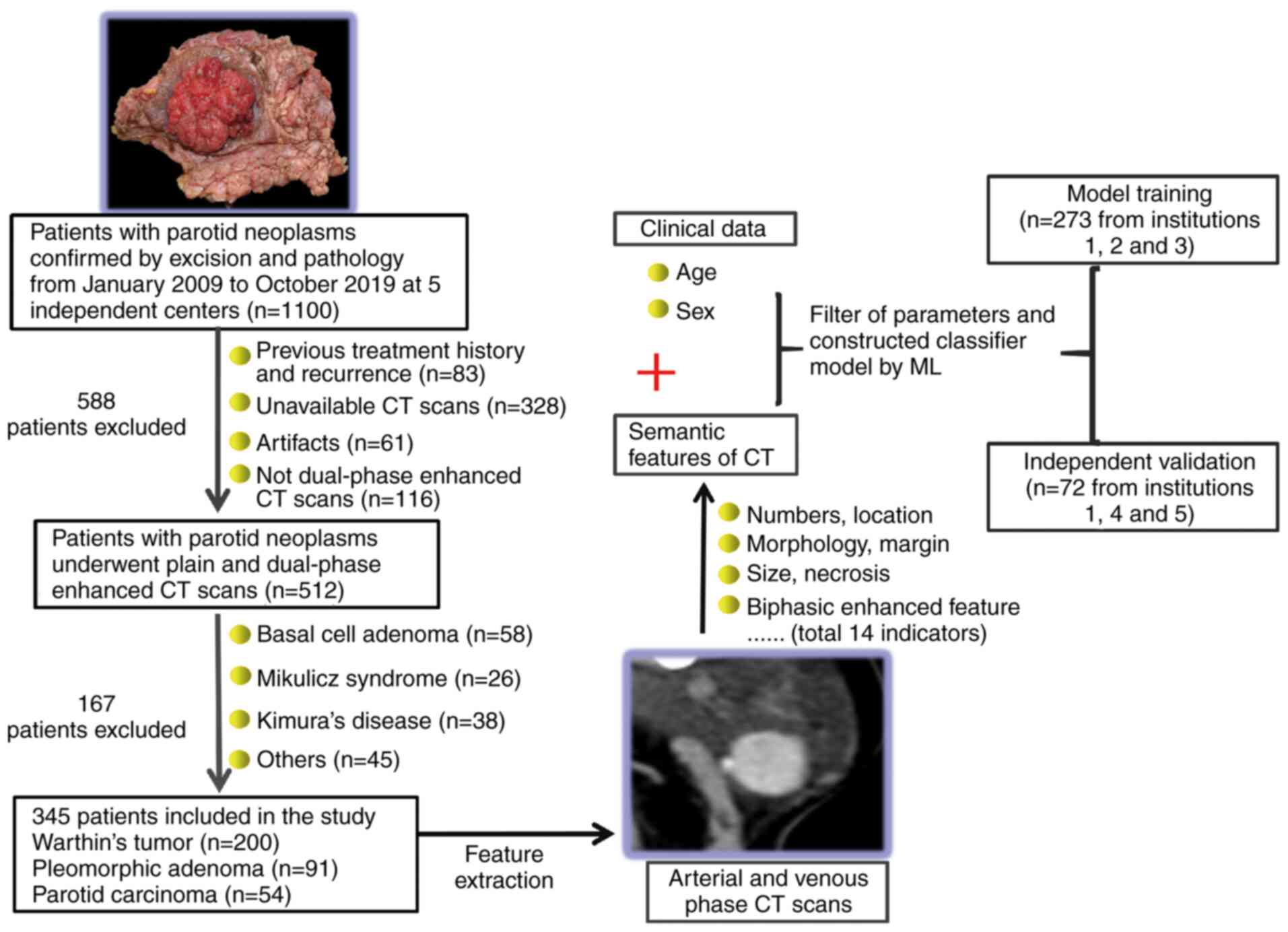|
1
|
Eissa L, Seif SA, Desooky SE, Eid M and
Koraitim T: Accuracy assessment of combined diffusion weighed and
dynamic gadolinium MR sequences in characterization of salivary
gland tumors. Egypt J Radiol Nucl Med. 47:127–139. 2016.
|
|
2
|
Razek AAK, Samir S and Ashmalla GA:
Characterization of parotid tumors with dynamic susceptibility
contrast perfusion weighted magnetic resonance imaging and
diffusion-weighted MR imaging. J Comput Assist Tomogr. 41:131–136.
2017.PubMed/NCBI View Article : Google Scholar
|
|
3
|
Xu Z, Zheng S, Pan A, Cheng X and Gao M: A
multiparametric analysis based on DCE-MRI to improve the accuracy
of parotid tumor discrimination. Eur J Nucl Med Mol Imaging.
46:2228–22344. 2019.PubMed/NCBI View Article : Google Scholar
|
|
4
|
Razek AA: Characterization of salivary
gland tumours with diffusion tensor imaging. Dentomaxillofac
Radiol. 47(20170343)2018.PubMed/NCBI View Article : Google Scholar
|
|
5
|
Xu ZF, Yong F, Yu T, Chen YY, Gao MY, Zhou
T, Pan AZ and Wu RH: Different histological subtypes of parotid
gland tumors: CT findings and diagnostic strategy. World J Radiol.
5:313–320. 2013.PubMed/NCBI View Article : Google Scholar
|
|
6
|
Fan Y, Chen C, Zhao F, Tian Z, Wang J, Ma
X and Xu J: Radiomics-based machine learning technology enables
better differentiation between glioblastoma and anaplastic
oligodendroglioma. Front Oncol. 9(1164)2019.PubMed/NCBI View Article : Google Scholar
|
|
7
|
Hua X, Huang X, Huang ZZ, Song CG, Deng
JP, Long ZQ, Lin HX and Yuan ZY: Establishment of prognostic
nomograms based on skeletal muscle index and serum biomarker in
breast cancer patients receiving radiotherapy. Clin Transl Med.
10(e115)2020.PubMed/NCBI View
Article : Google Scholar
|
|
8
|
Jin GQ, Su DK, Xie D, Zhao W, Liu LD and
Zhu XN: Distinguishing benign from malignant parotid gland tumours:
Low-dose multiphasic CT protocol with 5-minute delay. Eur Radiol.
21:1692–1698. 2011.PubMed/NCBI View Article : Google Scholar
|
|
9
|
Xu Z, Rong F, Yu T, Chen YY, Gao Q, Zhou T
and Pan AZ: Pleomorphic adenoma versus Warthin tumor of the parotid
gland: Diagnostic value of CT perfusion imaging and its pathologic
explanation:CT Perfusion of pleomorphic adenoma versus Warthin. J
Tumor. 4:419–425. 2016.
|
|
10
|
Yuan Y, Tang W and Tao X: Parotid gland
lesions: Separate and combined diagnostic value of conventional
MRI, diffusion-weighted imaging, and dynamic contrast-enhanced MRI.
Br J Radiol. 89(20150912)2016.PubMed/NCBI View Article : Google Scholar
|
|
11
|
Matsusue E, Fujihara Y, Matsuda E,
Tokuyasu Y, Nakamoto S, Nakamura K and Ogawa T: Vanishing parotid
tumors on MR imaging. Yonago Acta Med. 61:33–39. 2018.PubMed/NCBI View Article : Google Scholar
|
|
12
|
Kato H, Kanematsu M, Watanabe H, Mizuta K
and Aoki M: Salivary gland tumors of the parotid gland: CT and MR
imaging findings with emphasis on intratumoral cystic components.
Neuroradiology. 56:789–795. 2014.PubMed/NCBI View Article : Google Scholar
|
|
13
|
Ji GW, Zhu FP, Xu Q, Wang K, Wu MY, Tang
WW, Li XC and Wang XH: Machine-learning analysis of
contrast-enhanced CT radiomics predicts recurrence of
hepatocellular carcinoma after resection: A multi-institutional
study. EBioMedicine. 50:156–165. 2019.PubMed/NCBI View Article : Google Scholar
|
|
14
|
Colakoglu B, Alis D and Yergin M:
Diagnostic value of machine learning-based quantitative texture
analysis in differentiating benign and malignant thyroid nodules. J
Oncol. 31(6328329)2019.PubMed/NCBI View Article : Google Scholar
|
|
15
|
Ding J, Xing Z, Jiang Z, Chen J, Pan L,
Qiu J and Xing W: CT-based radiomic model predicts high grade of
clear cell renal cell carcinoma. Eur J Radiol. 103:51–56.
2018.PubMed/NCBI View Article : Google Scholar
|
|
16
|
Gessert N, Bengs M, Wittig L, Drömann D,
Keck T, Schlaefer A and Ellebrecht DB: Deep transfer learning
methods for colon cancer classification in confocal laser
microscopy images Int J Comput Assist Radiol. Surg. 14:1837–1845.
2019.PubMed/NCBI View Article : Google Scholar
|
|
17
|
van Griethuysen JJ, Fedorov A, Parmar C,
Hosny A, Aucoin N, Narayan V, Beets-Tan RG, Fillion-Robin JC,
Pieper S and Aerts HJ: Computational radiomics system to decode the
radiographic phenotype. Cancer Res. 77:e104–e107. 2017.PubMed/NCBI View Article : Google Scholar
|
|
18
|
Bellingegni AD, Gruppioni E, Colazzo G,
Davalli A, Sacchetti R, Guglielmelli E and Zollo L: NLR, MLP, SVM,
and LDA: A comparative analysis on EMG data from people with
trans-radial amputation. J Neuroeng Rehabil. 15(82)2017.PubMed/NCBI View Article : Google Scholar
|
|
19
|
Xiao qing D and Hong cai C: Feature
extraction using a fusion method based on sub-pattern row-column
two-dimensional linear discriminant analysis. Journal of Computer
Applications. 12:3593–3598. 2014.
|
|
20
|
Zhu Y and Ding Y: Auto-optimized
paralleled sinogram noise reduction method based on relative
quality assessment for low-dose X-ray computed tomography. J Med
Imaging Health Informatics. 7:278–282. 2017.
|












